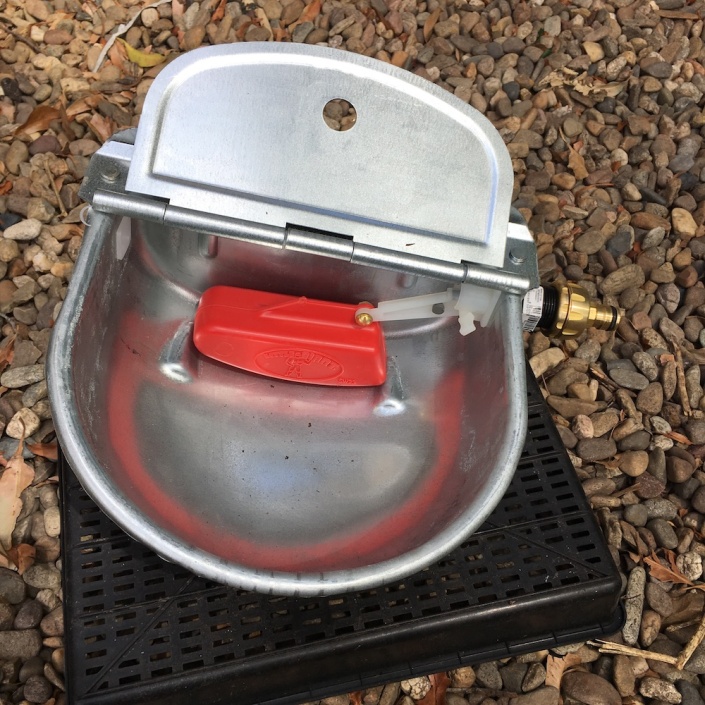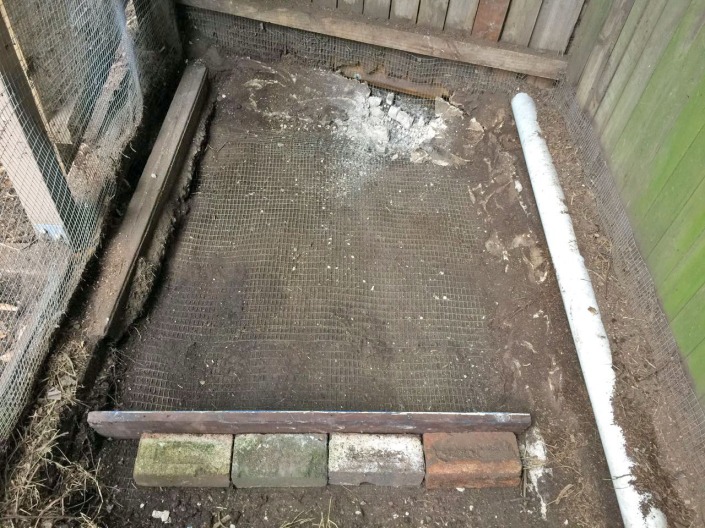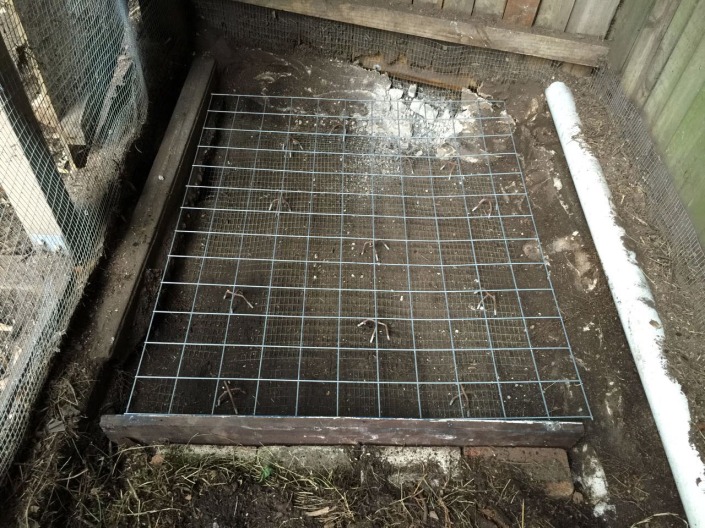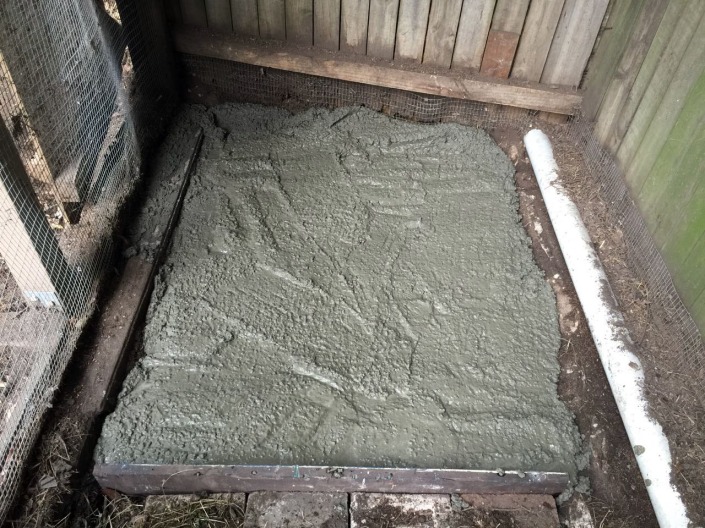chickens
Helping city chickens with country technology
With our time now split between the city and our farm, it’s a bit harder to look after our flock of chicken. While our neighbours are happy to help out (in return for eggs!), the less that has to be done, the better.
Enter some tried-and-tested country technology: the automatic waterer.

This uses a ‘float valve’ to automatically cut the water when it reaches a specific height. When the animals drink from it and the levels drops, the water source cuts back in.
You won’t find this handy item at the local Bunnings; it is easy to find at a farm supply shop in the country. While it’s intended for horses, cattle, etc it works perfectly well for chickens.
This particular unit comes from the USA, and it has a 1/2″ connection for the water. With a bit of hunting in Bunnings I found a plastic adapter that went from 1/2″ to 3/4″, to which I could then add a standard hose fitting. Then it’s just click in the hose and you’re done.
One less thing to do in this busy life, plus happy chickens!
Concrete slab in the chicken run versus rats

As anyone who has chickens in an urban setting knows, the big enemy are rats. They’re cunning and determined, and given a chance they’ll eat all the chicken feed, and anything else they can find.
Three years ago we ran wire underneath the whole chicken run, in order to keep the rats out. The wire has held up very well, but there’s been a renewed push from the rats in recent months. This includes creating a number of underground tunnels and burrows, testing whether they can get access from underneath.
Concerned that they would become motivated enough to chew through the wire (which they can!), I decided to implement a more permanent solution.

The first step was to clear down to the layer of chicken wire running across the bottom of the chicken run.

I then laid down a grid of galvanised iron, to provide reinforcing for the concrete slab. This is held off the ground by a series of spacers.

The day before I’d headed to the local hardware store, and picked up fourteen bags of ready-mix concrete (thank goodness I’ve now got a ute!).

I mixed the concrete in my wheelbarrow, 2-3 bags at a time. In total, the whole process took about four hours, from the initial clearing through to a freshly-poured slab.The total cost was about $160, including the concrete and wire.
It was also good exercise!

At first the chickens weren’t sure about the slab, and were hesitant to walk on it. They’re over that now.
I’m also expecting the concrete slab to be re-buried underneath soil and mulch within a week, once the chickens get scratching. (The wire was previously buried under a foot of accumulated material.)
The plan is also to progressively pour further slabs, working up the chicken run.
Update: within 24 hours the rats gnawed a hole through the wire above ground to get in to the chicken run. Doh! Further reinforcing has been done, and I’m going to pour a little more concrete in some key areas of weakness.
I may have won this battle, but the war against rats continues…
A wheelbarrow full of coffee grounds

It’s not every day that you end up with a wheelbarrow full of used coffee grounds, but I’m looking forward to making it a regular occurance at Lewisham House.
A little while back, a new cafe opened up just down the road, The Pig & Pastry. Other than their passion for great food, they also have a real interest in environmental issues. This includes some lovely raised garden beds set up in their backyard, for vegetables and herbs.
A week ago I approached them with a strange question: “what do you do with your used coffee grounds?”. Nothing as it turns out!
Coffee grounds are much loved in the permaculture community, as a source of free fertiliser for the garden. Apparently they deter (or hopefully kill?) slugs and snails, and the grounds are a particular favourite of citrus trees.
Online there are a number of long conversations about the relative merit of coffee grounds, including whether they’re too acid, and their effect on chickens. The general consensus is that when they break down, they become more neutral, and they don’t appear to be too toxic for chickens.
So I’ve left several plastic buckets down at the cafe, and I’ll drop down every week with a wheelbarrow to pick up the grounds. This saves them rubbish fees, and keeps my compost bins happy. A win all round!
Keeping rats out of the chicken run

“Rat cunning.” It’s an expression you hear, but you don’t fully understand until you see them in action.
When we created our chicken run, we ran aviary mesh up the sides of the run, and chicken wire across the top. Old concrete garden edges were dug 30cm into the ground on all sides, locking down the wire.
We thought it would be enough to keep out the rats. Boy were we wrong!
Within a month, rats started tunneling under the fence from the convent next door. They went under the concrete edging, and opened up new holes every night. (It doesn’t help that we back onto the railway line, which is both rat haven and highway.)
While the the chickens themselves were safe in their Fort Knox of chicken coops, the rats were scavenging any feed scattered about by the hens.
So I spent the last few weekends digging up the chicken run, laying down wire, and then cementing in the gaps. A lot of work, but hopefully the chickens should be safe now.
Of course, the wire will rust away in a few years. Had we known what we know now, we’d have bitten the bullet and laid a concrete slab when we created the run.
Still, this should last a while. And maybe when these defenses fail, I’ll be feeling more enthusiastic about laying a slab.
The take-away message: don’t underestimate rats, particularly when you live in the inner-city.
Constructing our chicken coop

With the house renovation essentially finished, our attention has turned to the garden. The highlight so far is adding chickens to our family, an essential part of any inner-city permaculture system.
The photos in this post show key steps of the construction process. This is one massively over-engineered chicken coop, which all comes down to the mindset you have when starting the project. If you’ve come from a bit of light DIY, then you build something simple. If you’ve come from six months of building a house, as we have, then you build … a small house.
The upside is that, following the grand tradition of backyard coops, it does mean that all the left-over building materials can be recycled into the coop. It should also last for a while 🙂
A few construction notes:
- The coop sits on a base frame of recycled hardwood, 500mm above ground level. This gives some protection against rats, termites and general rotting. It also gives the girls somewhere to shelter from the sun and rain, and they spend a lot of time napping under the coop.
- The coop is quite high, for no real reason other than avoiding the need to crouch when cleaning it out.
- The nesting boxes are made out of recycled eco-ply from the kitchen, and they give easy external access (for when they finally decide to start laying!).
- An old curtain rail provides a roost, and they happy put themselves to bed each night.
- The coop is connected to a chicken run beside the fence. By working against the boundary, only two new fences needed to be built.
- Learning from the nuns next door, the run is built like fort knox, to protect against foxes (oh yes!), rats (heaps) and scavenging birds. This includes aviary mesh on the sides (tucked underground and weighed down with old concrete garden edging), and chicken wire across the top. Every gap has been plugged to the best of our ability.
- The feeder and water are all suspended off the ground, again for proof against rats.
- While we lock them up in the coop each night, the run is secure enough to leave them out if we have to go away for a week.
We now have three chickens happily clucking around. Two Isa Browns, and a “something else” (inherited from relatives). No eggs as yet, but the Isa Browns are still very young, and the older bird was moulting when we got her.
And now for the construction photos…






